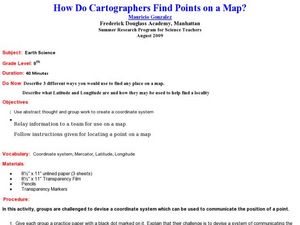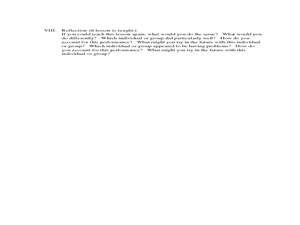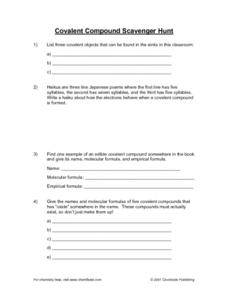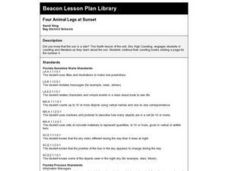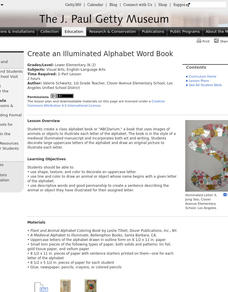Curated OER
The Senses
For this senses worksheet, learners describe the difference in sounds heard with a spoon. Then they describe how each object creates a sound and why. Students also explain the process of sound moving through the outer and inner ear.
Curated OER
Adjective Clauses Where/Which
In this adjective clause worksheet, middle schoolers find what is wrong with the 5 sentences and fix them. They then use the adjective clause to describe the object and subject and to complete 8 sentences.
Curated OER
How Do Cartographers Find Points on a Map?
Ninth graders describe latitude and longitude and how they may be useful to find things on a map. In this cartography lesson students divide into groups and devise a coordinate system that can be used to communicate a position.
Curated OER
Adverb or Adjective
Sixth graders choose adjectives to describe an object given by the teacher and share with the class, then do the same for a verb, choosing an adverb to modify each. In this adjective or adverb lesson, 6th graders review the difference...
Curated OER
Characterization
Students draw pictures to generate ideas about a character. They use prewriting skills to plan written work. They then dictate or write detailed descriptions of familiar person, places, objects, or experiences.
Curated OER
Incredible Seeds
Second graders are given a group of seeds and put in small groups. They classify their seeds based on their observations with 90% accuracy. Students draw a picture of each seed showing at least 2 characteristics of each. They write 1...
Curated OER
Geometric Figures and the Coordinate Plane
Sixth graders explore geometric figures. In this geometry lesson plan, 6th graders manipulate properties and relationships of geometric figures to identify objects on the coordinate planes and describe where figures sit on the planes.
Curated OER
Investigating Crickets and Their Body Parts
Second graders investigate the body of a cricket. In this biology lesson plan students use tools to gain information about the insect the cricket. Students observe and identify features and describe how these features help the cricket...
Curated OER
Bell Curve
Students construct two bell curves using two different yet related objects. For example, two kinds of Hershey's Kisses (plain and almond) or two kinds of dried beans (kidney and lima).
Curated OER
Bell Curve
Students explain normal distribution of a measurable characteristic within a group of objects. They create two graphs (one for each type of Hershey's Kiss) with increments of measurement on the X-axes and number of measurements on the...
Curated OER
When Push Comes to Crunch
Eighth graders engage in an experiment which uses an inclined plane and balls of various masses to determine the effect a large object has on a small object. They study velocity, momentum, gravity and forces.
Curated OER
Dichotomous Keys
Students classify objects and organisms using a dichotomous key. They are shown a demo by the teacher and then practice on their own. They discover why classification is important.
Curated OER
Living and Non-Living
Fourth graders are divided into small groups and collect 4 objects from the playground. They take 5 to 10 minutes to classify their groups and discuss their findings including the terms "living" and "non-living". As a class they discuss...
Curated OER
Hopping Across the Solar System
Students role-play and communicate that objects in space have describable properties, locations, and movements. Students identify and communicate effectively that Earth is the third planet from the Sun in the solar system, eight other...
Curated OER
MINI-UNIT on ELECTRICITY
Young scholars identify hypotheses related to static electricity, to begin to test the hypotheses, to begin to develop conclusions related to observations, to demonstrate that like charges repel and unlike charges attract each other, to...
Curated OER
Science: Different Levels of Density
Students observe experiments in density and describe the results. In the experiment, milk, corn syrup, and oil are added in different orders to three glasses, while one other glass contains only water. As objects are dropped into each...
Curated OER
Covalent Compound Scavenger Hunt
In this chemistry activity, students look for the covalent compounds while examining the objects in the classroom. They also apply the knowledge of formulas.
Curated OER
Look And Listen
Students bring their favorite thing to class as a visual aid while they describe it to their classmate. In this oral information lesson plan, students fill out a worksheet about their item that is provided.
Curated OER
Four Animal Legs at Sunset
First graders listen to the book, 1, 2, 3, To The Zoo, and focus on the one-to-one correspondence while counting the animals and other objects in the story. They create page number four in their number books.
Curated OER
Classification Schemes
Students place organisms into the correct classification and justify their reasoning. They must include all objects and have a reason for their decisions.
Curated OER
Create an Illuminated Alphabet Word Book
Students create a class alphabet book or "ABCDarium," a book that uses images of animals or objects to illustrate each letter of the alphabet.
Curated OER
How to Score in the Word Series
Students examine an object in the classroom and write a description of it employing exciting language. They brainstorm and outline ideas for an original article about an event they participated in or attended.
Museum of Science
Open Window: Using Leonardo's Perspectograph
Young scholars look through one eye and trace the outlines of objects seen through a window to create a drawing with natural and correct perspective.
Curated OER
Faberge Easter Egg
Students examine the Russian culture under the Czars and how there was a demand for intricate and beautiful objects. They attempt to create a "jewel-like" object out of an egg using a Spring template supplied by the teacher.


